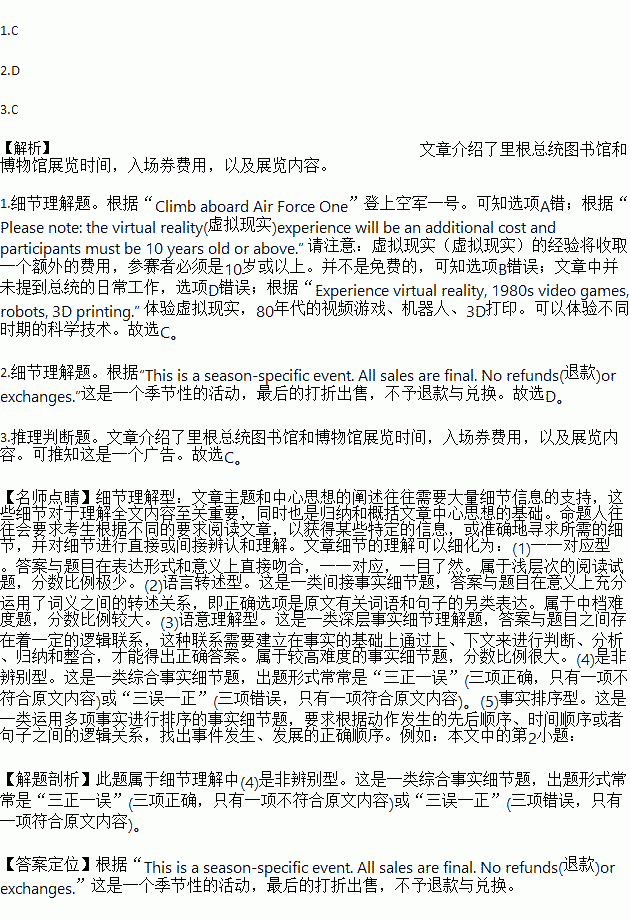题目内容
WELCOME TO THE RONALD REAGAN PRESIDENTIAL LIBRARY AND MUSEUM
Visit the limited-time “Interactive! The Exhibition” at the Ronald Reagan Presidential Library and Museum and save more than 30% on museum admission tickets with an audio tour.
WHEN
Through June. 28, 2017
WHAT’S INCLUDED
$19 (reg. $28)… Admission for one person to the Ronald Reagan Presidential Library and Museum, including “Interactive! The Exhibition” with an audio tour. Please note: the virtual reality(虚拟现实)experience will be an additional cost and participants must be 10 years old or above.
WHY WE LOVE IT
●The exhibition is a hands-on experience focusing on movies, TV, music and the arts.
●Experience virtual reality, 1980s video games, robots, 3D printing.
●Climb aboard Air Force One, view the expensive comfortable presidential car and a Marine One helicopter.
●Explore Reagan’s legacy(遗产): Step into an Oval Office copy and see a piece of the Berlin wall.
●The audio tour has more than 50 stops and original material not copied in the exhibits
WHAT YOU NEED TO KNOW
This is a season-specific event. All sales are final. No refunds(退款)or exchanges. Not valid after the expiration date. Valid any regular museum operating day through June. 28, 2017. Museum hours are 10 a.m.—5 p.m., seven days a week. Valid for one person. Cannot combine with other offers. Must use in one visit. Tickets include admission to “Interactive! The Exhibition” and the entire museum’s galleries and grounds.
1.What can visitors do while visiting the library and museum?
A. Fly on Air Force One.
B. Experience virtual reality for free.
C. Approach technology of different times.
D. Learn about the president’s daily routine.
2.What does the author say about the admission ticket?
A. It can be enjoyed with other offers.
B. It allows limitless visits to the museum.
C. It isn’t accessible to children.
D. It cannot be changed once sold.
3.What type of writing is this passage?
A. A notice.
B. An official report.
C. An advertisement.
D. A tour review.
Passage3
体裁 | 话题 | 词数 | 难度 | 建议时间 |
说明文 | 厄尔尼诺现象 | 382 | ★★★☆☆ | 8分钟 |
You may laugh it off if someone told you that extreme weather disasters were actually a child’s tricks. But El Nino, meaning "little boy" in Spanish, could be about to cause trouble.
A recent statement from the US National Oceanic and Atmospheric Administration warned of a strong El Nino event that may be similar to the strongest in modern times. Scientists believe that evidence shows a more than 90 percent chance that it is coming – and it’s going to be big. "If this lives up to its potential, this thing can bring a lot of floods, mudslides (泥石流), and trouble," said Bill Patzert, a NASA scientist.
El Nino is a climate event occurring in the Pacific Ocean. The wind usually blows strongly from east to west due to the rotation (旋转) of the Earth. This causes water to pile up in the Western Pacific and pulls up colder water from the bottom in the eastern part. However, in El Nino years, the winds pushing the water get weaker and cause the warmer water to shift back toward the east. This warms the ocean as it travels before finally reaching the shores of North and South America. In an El Nino event, the waters of the eastern Pacific can be up to 4 degrees Celsius warmer than usual.
Most El Ninos last from 9 to 12 months and their effects are felt around December. They don’t happen every year though, usually between every two to seven years.
Last seen in 1997-98, El Nino caused severe droughts in Australia, the Philippines and Indonesia, as well as deadly floods in Peru and Ecuador. The world also heats up during an ElNino – 1998 became the warmest year on record at the time. If the current trend continues, 2015 is almost certainly to become the hottest year yet again.
A strong El Nino also affects hurricane seasons around the planet. The warmer the Eastern Pacific is, the more hurricanes it gets. The Western Pacific, on the other hand, tends to see more and stronger typhoons.
The weather isn’t the only thing that’s affected. Warmer surface waters in the Eastern Pacific make the cold-water fish swim away and damage the fishing industry in much of Latin America.
【题文1】 What is the text mainly about?
A. El Nino and its harmful effects. B. Extreme weather disasters ever.
C. The hottest years ever in history. D. The strongest El Nino in history.
【题文2】Which of the following statements is TRUE about El Nino?
A. It results from hurricanes or typhoons in the oceans.
B. It happens every two years and last about half a year.
C. It is a weather phenomenon occurring in the Atlantic.
D. It can cause extreme weather, such as floods and droughts.
【题文3】 During an El Nino year, ________.
A. the wind blows so strongly that it causes the water to pile up
B. the fishing industry in much of Latin America is likely to suffer
C. the more typhoons it experiences, the warmer the Western Pacific is
D. the surface water in the Eastern Pacific usually gets colder than ever
【题文4】 El Nino in fact results from ________.
A. a little Spanish child’s trick
B. the natural rotating of the Earth
C.an American expert’s prediction
D. the weaker winds in the Pacific




